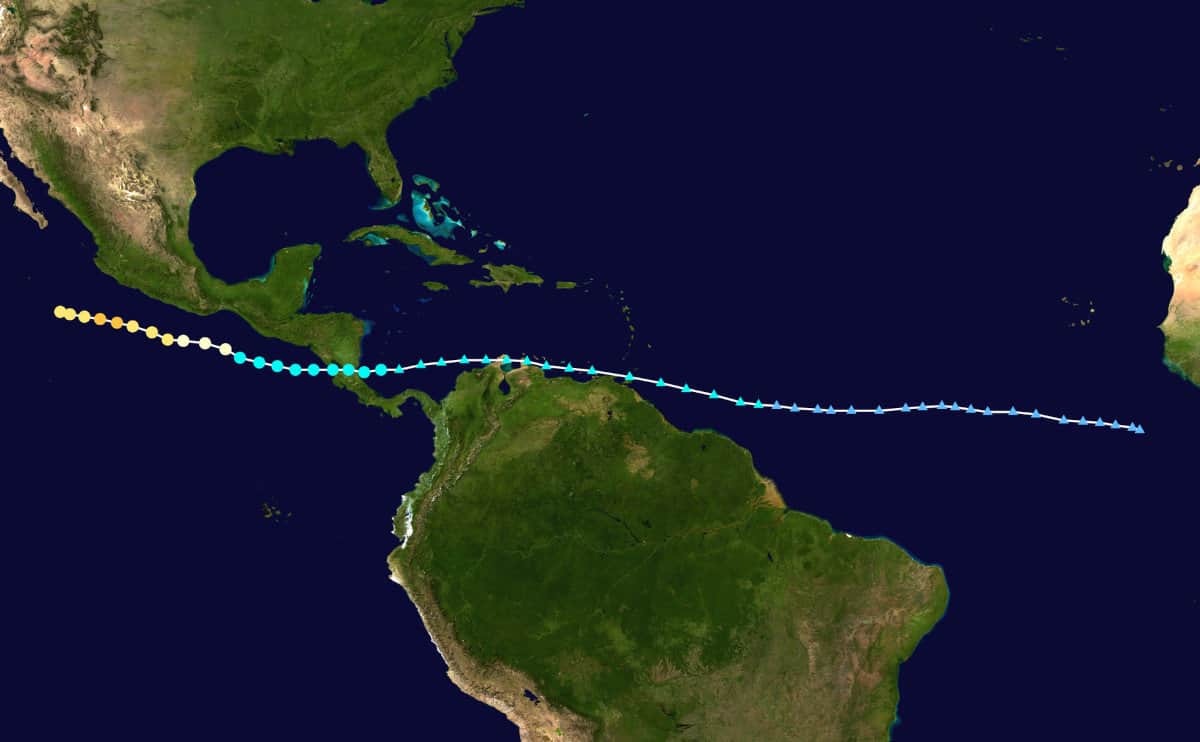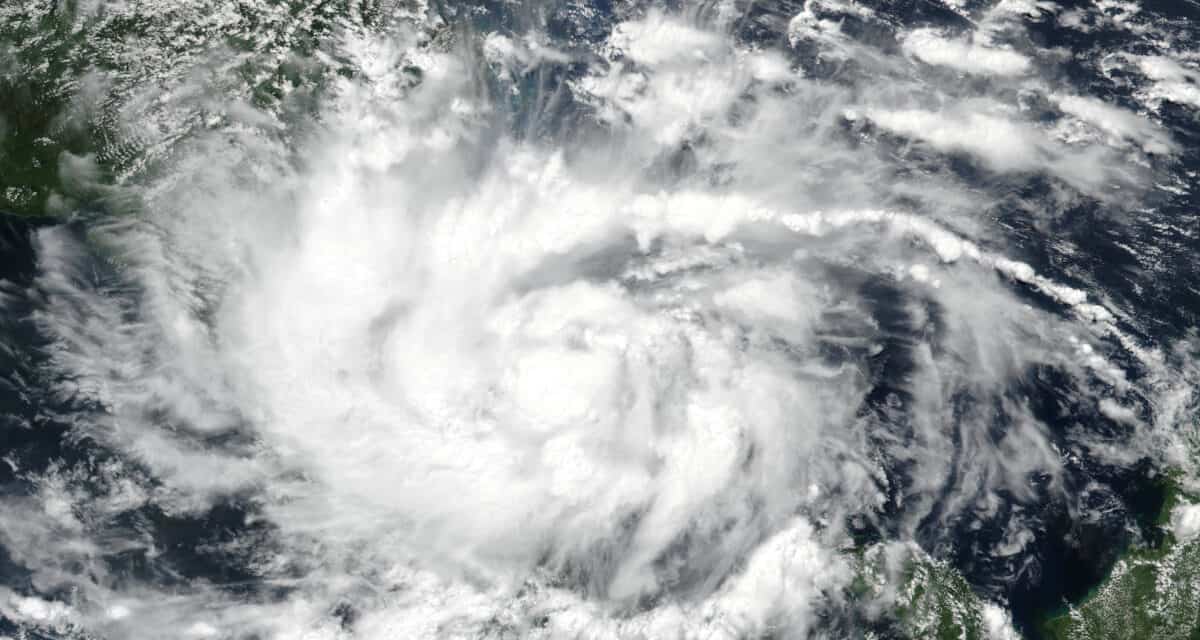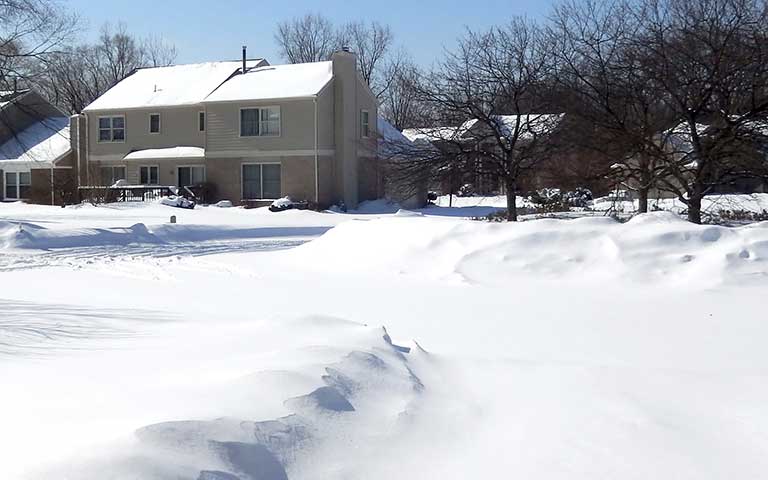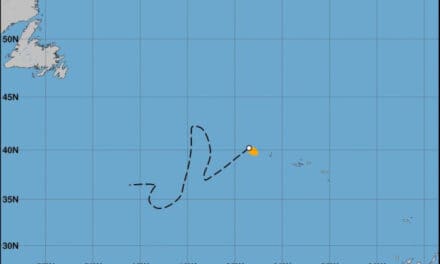Tropical Storm Bonnie makes landfall on the Nicaragual-Costa Rica border with 50 MPH sustained winds. NOAA satellite image.
First July Storms Form Over Long Independence Day Weekend.
Two tropical storms formed over the July 4 weekend. Bonnie made landfall on Central America while Colin organized suddenly and unexpectedly off South Carolina. The two named storms are the second and third storms of the 2022 Atlantic Hurricane Season.
Forecasters have warned that 2022 could turn into another season of above average activity. The 2022 Forecast includes up to 20 named storms, 10 hurricanes, and 5 major hurricanes. An average season based on a thirty-year average from 1991 to 2020 has about 14 named storms, 7 hurricanes, and 3 major hurricanes.
Tropical Storm Bonnie Crosses Central America

Storm track for Tropical Storm Bonnie across the tropical Atlantic, Caribbean Sea and Central America to the Pacific Ocean. Bonnie became a hurricane after reaching the Pacific.
National Hurricane Center Graphic.
The National Hurricane Center began watching a tropical wave that moved off the coast of Africa on June 23 with disorganized thunderstorms. As the wave moved across the tropical Atlantic, it slowly became better organized. On June 27, the NHC began issuing advisories and bulletins on Potential Tropical Cyclone Two, with a likely track along the northern coast of South America.
7 Hurricane Preparedness Checklist Items You Don’t Want to Miss
Despite sustained tropical storm force winds, the system did not organize into a tropical cyclone because of interaction with land until July 1. Forecasters named it Tropical Storm Bonnie. Bonnie intensified over the warm Caribbean Sea until it made landfall near the Costa Rica-Nicaragua border on July 2 with peak sustained winds of 50 MPH.
Tropical Storm Bonnie maintained organization once over land to cross Central America and emerge into the Pacific Ocean as a tropical cyclone. As of July 6, Hurricane Bonnie is a Category 2 Storm directly south of the Baja Peninsula. It should retain hurricane strength for the next two days until it weakens sometime on Friday, July 8.
Nicaragua reported Bonnie caused four fatalities.
Tropical Storm Colin

Tropical Storm Colin formed rapidly from a low pressure system with a minimal chance of organization prompting storm warnings and cancelling Fourth of July events. NOAA Satellite Image.
Early on July 1, the National Hurricane Center noted an area of low pressure off the coast of Georgia with a minimal chance of development. The low moved inland over South Carolina during the day while developing deep convection close to the center and becoming well organized.
How to Prepare for a Power outage
The NHC named Tropical Storm Colin early on July 2, about 50 miles from Myrtle Beach, South Carolina. Colin had 40 MPH sustained winds at its strongest. Almost as quickly as it formed, Colin weakened and elongate. By late on July 2, Colin had weakened to a tropical depression and dissipated less than half a day later over North Carolina.
Colin’s unexpected formation prompted storm warnings in South Carolina and North Carolina and North Carolina, causing the cancellation of July 4 celebrations in Charleston and Southport. The storm’s winds caused high surf conditions and one man drowned on an Oak Island Beach.
Expect Increasing Activity
Tropical activity should increase gradually through the month of July and more rapidly in August as the season moves towards the peak around September 10. The three named storms have not intensified to a hurricane, but that could change with any storm. Meanwhile, the Caribbean Sea, Gulf of Mexico, and Tropical Atlantic are warm, and the Equatorial Pacific is cool—a combination that sets the stage for more tropical storms and hurricanes in the Atlantic Basin.
Hurricane Preparedness
- Hurricane Hazards and Risk Factors
- Make a Hurricane Evacuation Plan
- Hurricane Preparedness Kits and Supplies
- Hurricane Insurance Checkup and Updates
- Prepare Your Home for Hurricanes
- Help Neighbors with Hurricane Preparedness
- Complete Your Hurricane Preparedness Plan
- Emergency Preparedness Tips
- How to Prepare for a Power Outage
- 10 Tips to Survive a Hurricane Disaster
- FEMA Recommends a Generator
- Hurricane Disaster Preparedness
















